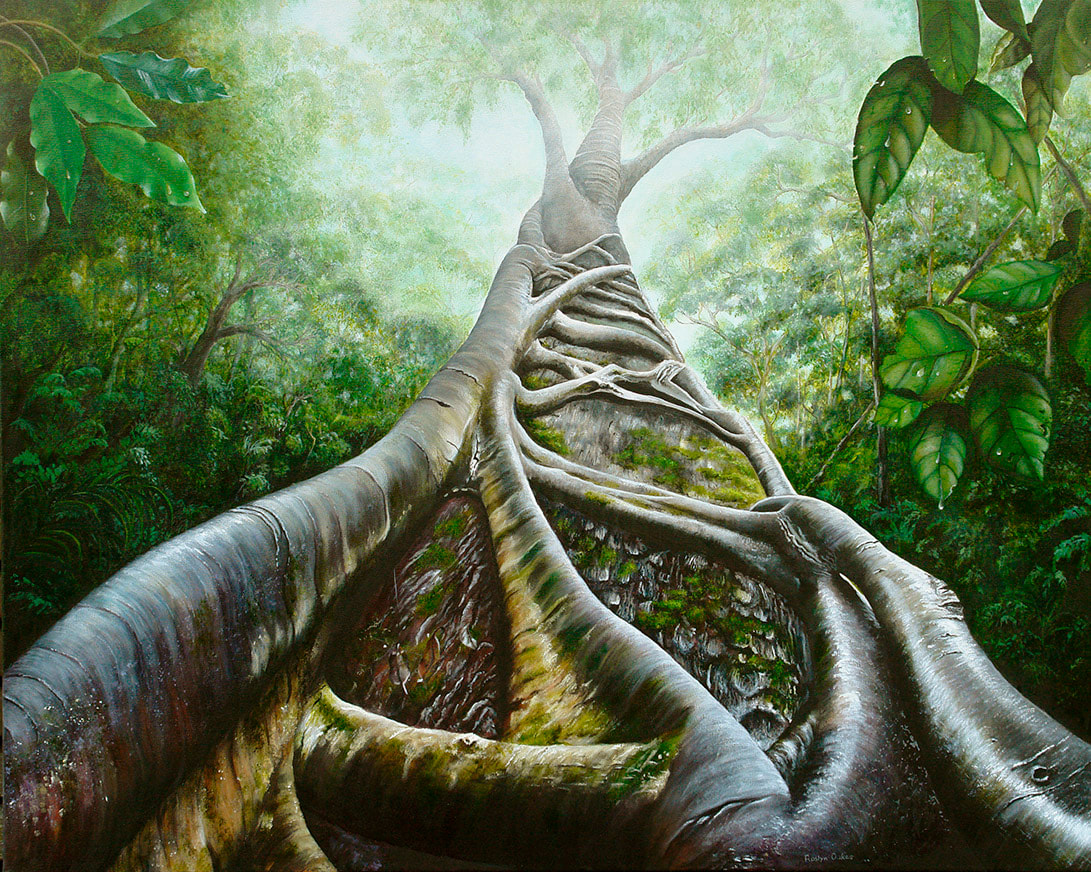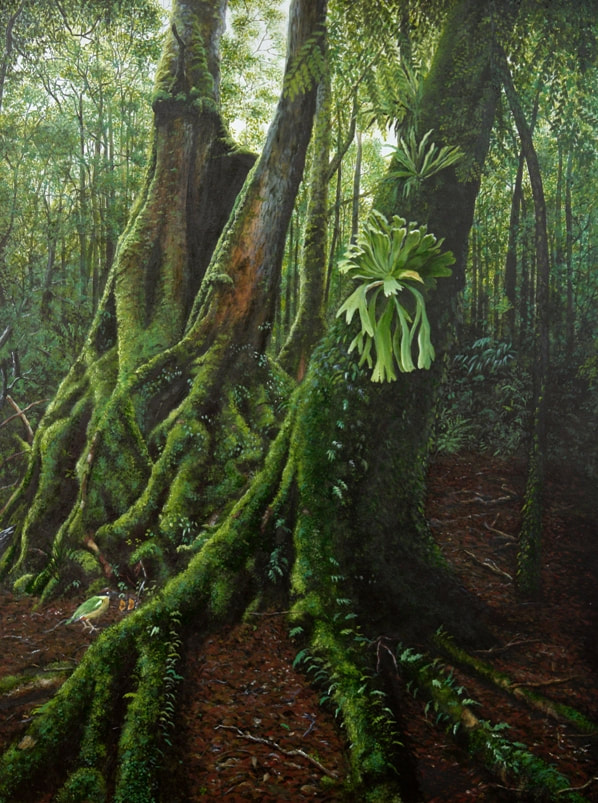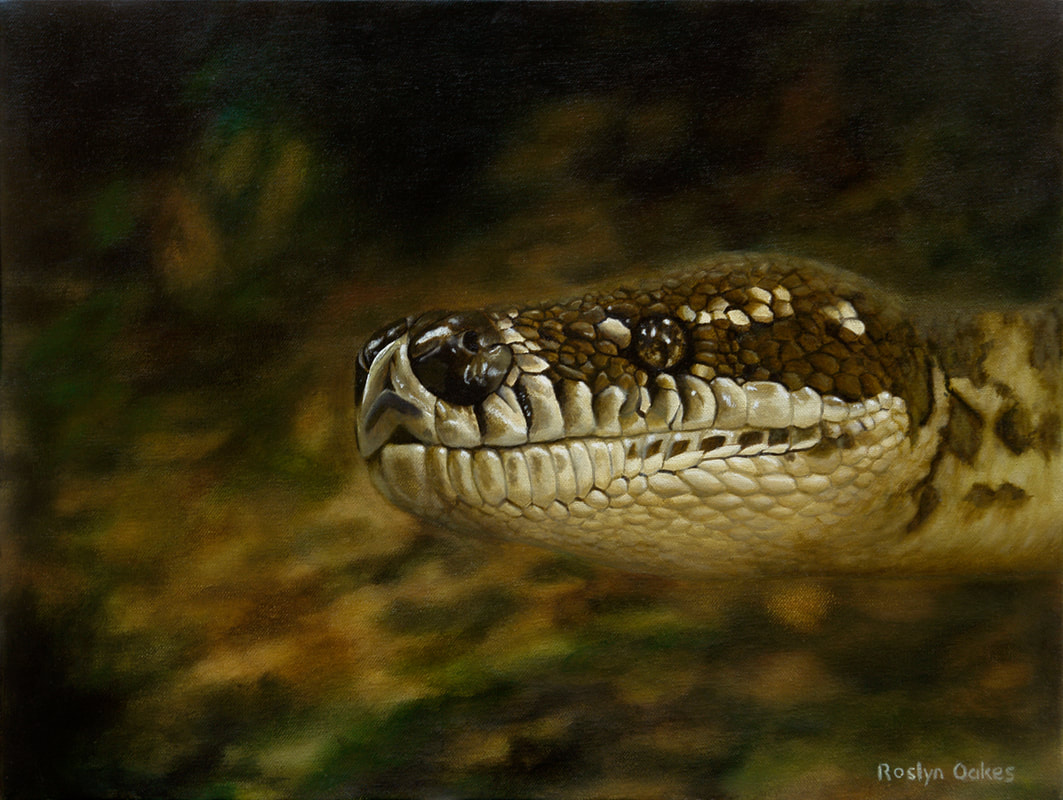The Art of Roslyn Oakes
Murwillumbah
|
I drew prolifically as a child. It was my “go to” form of entertainment since I missed a lot of schooling due to health issues. Painting on canvas came much later.
After my share of life's dramas (including single-handedly raising two children and renovating an old house) it was time to do something for myself. I commenced art classes with Graeme Stevenson of 'Colour in your Life' fame. Subsequently, while working in aged care, I began to conduct art classes for residents in our local nursing home. The talent, creativity and happiness of these people through the joy of art is amazing and the classes continue to this day. My involvement with the Caldera Wildscapes Gallery allows me to indulge my love of nature and the natural environment which features predominately in my work and provides a constant source of inspiration. |
|
Silent Flight - Australian Barn Owl Oil The Australian Barn Owl, Tyto alba deliculata (meaning 'the delicate white owl') is well known for its ghostly beauty and silent flight. Contrasted to that, its calls vary from a breathy hiss to an unearthly shriek. The barn owl is one of the most wide-spread of all land birds, being found on all continents (except Antarctica). Their favourite food is the common house mouse and introduced rat species which sadly contributes to the owls demise every year due to secondary poisoning as a direct result of human pest control methods. |
|
Grab Hold & Don't Let Go - Strangler Fig Acrylic The strangler fig starts life as a tiny seed germinating in the branches of a host tree. As the seedling grows in the canopy, it sends down a network of roots to the ground below. As the roots grow larger and more numerous these 'arms' slowly 'strangle' the host tree which eventually dies and rots away leaving the now free standing fig with a hollow trunk. Mature specimens can grow to 60 metres in height. The hollow trunk provides homes for thousands of invertebrates, rodents, bats, reptiles, amphibians and birds. The fruit is very nutritious and tasty when ripe attracting a variety of bird species, especially pigeons. |
|
Peanut Tree Pods (Red-fruited Kurrajong) Sterculia quadrifida Soft pastel This rainforest tree grows to a height of five to ten metres and is relatively common in the Tweed region. The attractive seed pods are bright orange or red when ripe and contain up to eight shiny black seeds. These may be eaten raw or roasted (once the paper-like skin is removed) and taste rather like peanuts. The bark of the Peanut Tree was used by aboriginal people in their traditional weaving techniques to make baskets for collecting other rainforest fruits and seeds. The vibrant colours of these pods are amazing and, along with the textures, were a perfect subject for the soft pastel medium. |
|
Ancient Relics - Antarctic Beech Acrylic The Antarctic Beech tree grows in cool temperate rainforests from Barrington Tops to the Tweed caldera's higher altitude national parks. One would think that the terms 'Antarctic' and 'rainforest' are mutually exclusive but this species is a remnant from the ancient Gondwana super continent when Australia, South America and Antarctica where connected. It can grow up to 50 metres in height, and usually reproduces by coppicing from a 'mother' tree with specimens such as this one being over a thousand years old - festooned with mosses and epiphytes. The colourful Noisy Pitta forages through the moist, decomposing leaf litter of the forest floor in search of grubs and insects. It usually nests in well hidden nooks within the buttresses of rainforest trees. |
|
Python Portrait Oil The humble carpet python is relatively common in the Tweed Shire and seen in a variety of habitats. It occasionally takes up residence in sheds and rooves of houses and is adept at catching rats. I hope that more people will come to appreciate these beautiful and elegant animals, as I do, and give them the respect they deserve. They are normally quiet and good natured unless hungry, threatened or shedding its skin. Some people wrongly kill these snakes with the attitude “a dead snake is a good snake”, how wrong they are. |
|
Watching Me Watching Ypu Tawny Frogmouth Oil The Tawny Frogmouth, often confused with owls, is more closely related to kookaburras and nightjars (also ground feeding masters of camouflage). During the day they generally perch unobtrusively in a tree, their plumage and posture resembling a dead branch. The Tawny Frogmouth is found throughout Australia (including Tasmania) and is often seen around the Tweed and surrounding areas on dusk while out hunting. Unfortunately these birds are often hit by cars while chasing insects illuminated by headlights and attracted by streetlights. Reference photo for painting courtesy Karen Cox |
|
Rainforest View Acrylic The Gondwana Rainforests of Australia exist as some 50 separate parks and reserves from South East Queensland down to north of Newcastle, NSW. The Tweed caldera region is fortunate to have several major national parks established: namely Springbrook, Lamington, Border Ranges and Nightcap. Rainforests are the most diverse ecosystems on earth yet only covers 6% of the world’s surface. If this vital ecosystem is to survive, remaining areas of rainforest must be protected. Three quarters of NSW rainforest have disappeared since European settlement. Being in the rainforest always has a tranquil calming effect on me and I endeavoured to portray this tranquility in my painting. |
|
Out of the Mist - Intermediate Egret Oil The Intermediate Egret has entirely white plumage and sprouts long plumes during the breeding season. It is relatively common in the Tweed region where it shares waterways and wetlands with the larger Great Egret and the smaller Little Egret. I find these birds rather graceful, especially in flight. They look especially striking against a contrasting dark background, which inspired this composition. The sliver of early morning yellow light added colour to the painting. |
|
Barred Romance Barred Frogs Mixophyes species - amplexus Acrylic The male Barred Frog calls to the much smaller female with a deep guttural grunt from his hiding place in the leaf litter. The mating pairs enter the water, and the females flick fertilised eggs onto the bank where the first development stages are completed away from predators. The tadpoles are then washed into the creek by the first heavy rains. With warmer weather conditions and drought the Barred Frog’s habitat is under threat, as they need a damp environment to survive. These frogs are now listed as endangered in the Tweed region. Reference photo for painting courtesy John Pumpurs |
|
Serenity - Australian Darter Acrylic The Australian Darter is a tall streamlined bird with a long slender neck and head which, when the bird is swimming, is all that is visible above the water. They are frequently seen in Tweed estuaries and along rivers usually by the waters edge, or perched in a tree where they also like to nest. I love the stillness of these birds while drying their wings in the sunshine, and I have always been fascinated by their intricate markings when seen up close. |
|
Late Home for Dinner White-breasted Sea-Eagle Acrylic One of the Tweed caldera region's most majestic birds of prey, the White-breasted Sea-eagle catches its prey (mostly fish) by flying just above the surface of a waterway and then plunging its talons into the water and grasping its catch. Interestingly, the Osprey, also a mostly fish eater, actually plunges its full body into water to catch its prey. Contact Roslyn
|












